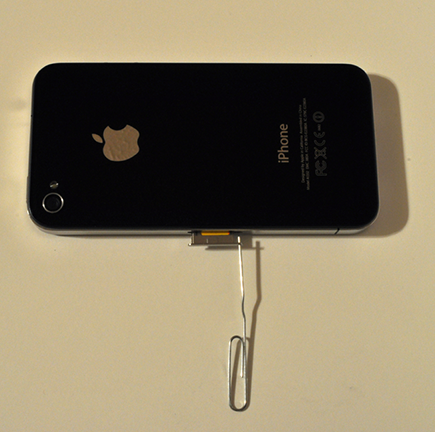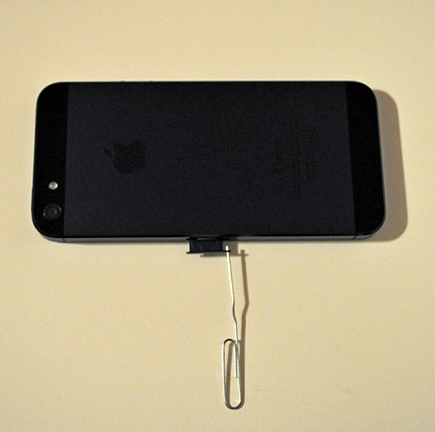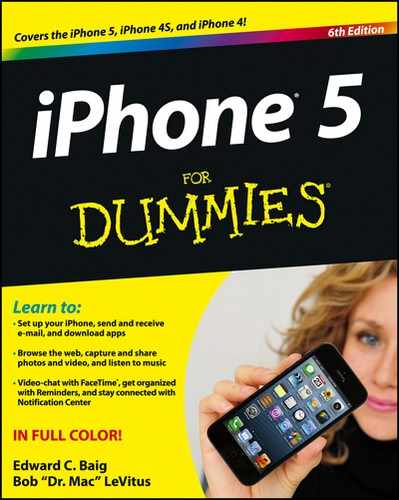Figure 16-1: Removing the micro-SIM tray on an iPhone 4 or 4S.
Problems with Calling or Networks
If you’re having problems making or receiving calls, problems sending or receiving SMS text messages, or problems with Wi-Fi or your wireless carrier’s data network, this section may help. The techniques here are short and sweet — except for the last one, restore. The inconvenient, time-consuming restore technique, which we describe in the preceding section, entails erasing all your data and media and then restoring it.
First, here are some simple steps that may help. Once again, we (and Apple) suggest that you try them in this order:
1. Check the cell signal icon in the upper-left corner of the screen.
If you don’t have at least one or two bars, you may not be able to use the phone or messaging function.
2. Make sure you haven’t left your iPhone in airplane mode, as described in Chapter 14.
In airplane mode, all network-dependent features are disabled, so you can’t make or receive phone calls, send or receive messages, or use any apps that require a Wi-Fi or data network connection (that is, Mail, Safari, Stocks, Maps, and Weather).
3. Try moving around.
Changing your location by as little as a few feet can sometimes mean the difference between four bars and zero bars or being able to use a Wi-Fi or wireless data network or not. If you’re inside, try going outside. If you’re outside, try moving 10 or 20 paces in any direction. Keep an eye on the cell signal or Wi-Fi icon as you move around, and stop when you see more bars than you saw before.
4. Try changing your grip on the phone (or if it’s an iPhone 4, try using a case).
Apple says, “Gripping any mobile phone will result in some attenuation of its antenna performance, with certain places being worse than others depending on the placement of the antennas. This is a fact of life for every wireless phone. If you ever experience this on your iPhone 4, avoid gripping it in the lower-left corner in a way that covers both sides of the black strip in the metal band, or simply use one of many available cases.”
5. Turn on airplane mode by tapping Settings on the Home screen, and then tapping the airplane mode On/Off switch to turn it on. Wait 15 or 20 seconds, and then turn it off again.
 Toggling airplane mode on and off like this resets both the Wi-Fi and wireless data-network connections. If your network connection was the problem, toggling airplane mode on and off may correct it.
Toggling airplane mode on and off like this resets both the Wi-Fi and wireless data-network connections. If your network connection was the problem, toggling airplane mode on and off may correct it.
6. Restart your iPhone.
If you’ve forgotten how, refer to the “Restart your iPhone” section, a few pages back. Restarting your iPhone is often all it takes to fix whatever was wrong.
7. Make sure your SIM card is firmly seated.
 A SIM (Subscriber Identity Module) card is a removable smart card used to identify mobile phones. You can change phones by moving the SIM card from one phone to another.
A SIM (Subscriber Identity Module) card is a removable smart card used to identify mobile phones. You can change phones by moving the SIM card from one phone to another.
To remove the SIM card, straighten one end of a fine-gauge paper clip and stick the straight end gently into the hole on the SIM tray, as shown in Figure 16-1 for the iPhone 4 and 4S and in Figure 16-2 for the nano-SIM used in the iPhone 5.


Figure 16-2: Removing the nano-SIM tray on an iPhone 5.
When the SIM tray slides out, carefully lift out the SIM card and then reinsert it, making sure it’s firmly situated in the tray before you gently push the tray back in until it locks.
If none of the preceding suggestions fixes your network issues, try restoring your iPhone as described previously, in the “Restore your iPhone” section.

